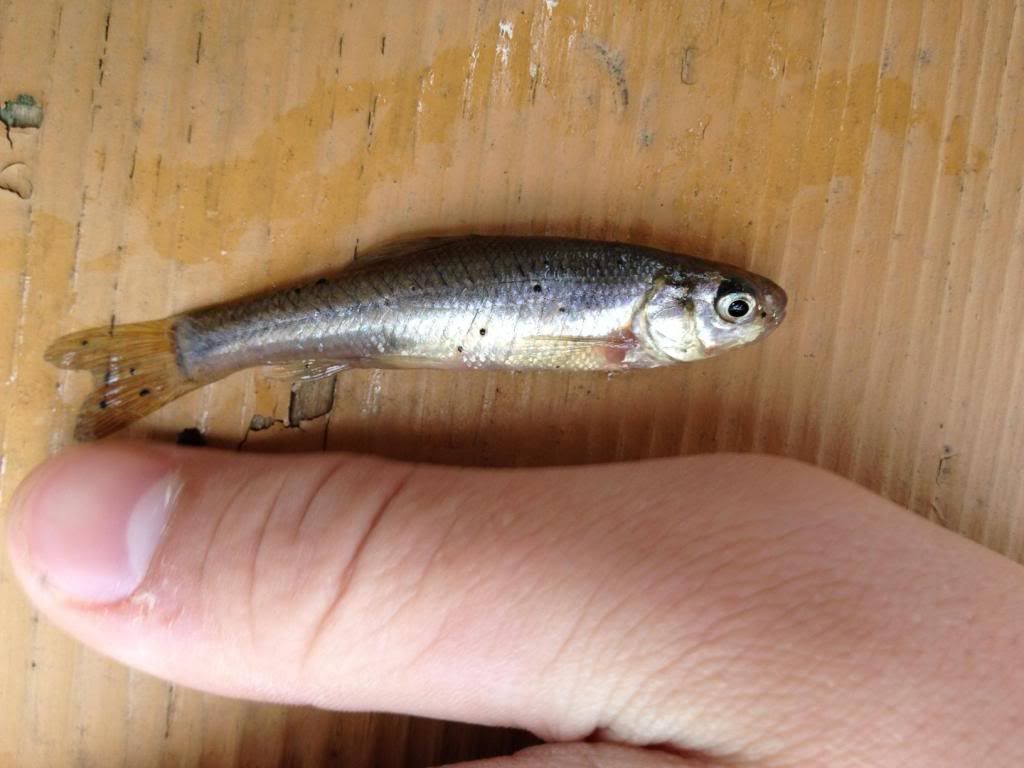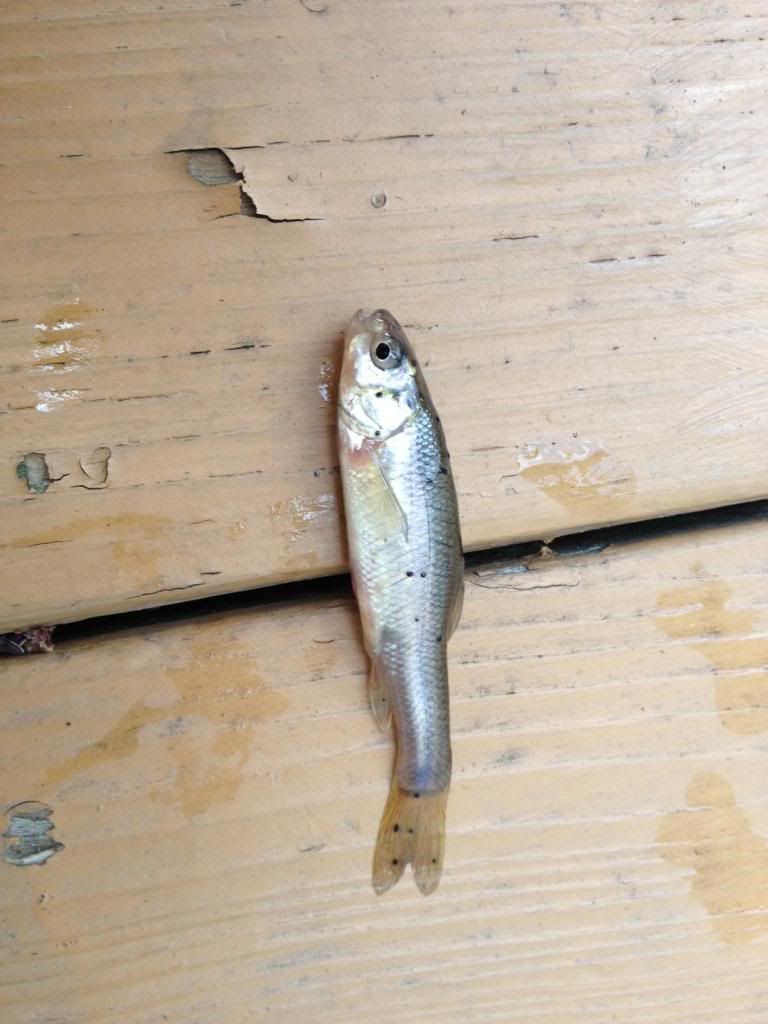Small BOW behind my house is loaded with these minnows. Its in the woods, nobody has touched it in years. They certainly look like FH to me but I most minnows look the same to me. Can anyone positively ID these guys?


The black dots(parasite?) and lack of a black stripe (lateral line??) have me 2nd guessing.
Thanks for the help! Scott
The nice thing about IDing fish is, there are only so many species they can be. Especially when they are living in a pond. When it comes to species of minnows/shiners living in ponds, the options narrow that much more.
I think the reason you aren't seeing a stripe is the water chemistry/clarity. The fish is an FHM.
Thank you, as I was waiting I did some more searching and came to the same general conclusion, either they were fatheads or they were bluntnose.
Thanks again, Scott
If you want to know what the black spots are, google fish black spot disease. Intermediary host are snails.....
These parasitic flatworms appear as tiny black spots on the skin, fins and flesh of fish. No method of control is available for the elimination of this problem. This organism does little harm to the fish. The main problem associated with black-spot is the unsightly appearance it may cause. Skinning infected fish will remove most black spots.
The life cycle of the parasite is quite complex. A fish-eating bird (typically a great blue heron or kingfisher) eats an infected fish. The black spot or worms are released and grow to sexual maturity in the bird's intestine. The adult worms pass eggs with the bird's droppings. When the eggs reach water, they hatch into free-swimming organisms which then penetrate snails for further development. Finally, after leaving the snails they burrow into the skin of fish and form a cyst. The fish surrounds the cyst with black pigment that gives the disease its name. If an infected fish is consumed by a bird, the cycle repeats itself.
Glad to know it isn't a big deal. I wonder if I put some snail eating sunfish in the pond it will help with parasites. Is it worth trying? I was going to use it as a forage pond so not sure if the sunfish will eat all my forage fish. Kind of a catch-22.
Should I not worry about it or would I be better off trying to control the snails.
Thanks, Scott
If the FH population is doing well and you are going to use it as a forage pond then leave it as is. Feeding a few pellets would help grow the FH and good spawning structure would help also.
You should give them a salt bath before putting them in another pond.
I bet the dark stripe becomes more obvious when spawning starts. Check and let us know.
Ok, have a salt bath setup. I found some info on it here and followed the instructions for a 1% solution before transfer.
Now before I continue, I caught this today. It is nearly 5" long. This looks like it could be a creek chub. This pond is in the woods. It is not creek fed as far as I can tell. There is a swampy marshy area adjacent but no creek. Am I on track here? Also, they aren't a problem to add to the bass pond are they? Seems they would just end up as LMB food.
Thanks, Scott

Yeah, that is a creek chub. Either someone bucket stocked it or during high water events, that pond gets over flow from a creek.
If stocked into a pond with bass, creek chubs make excellent bass forage. They just can't reproduce in ponds unless those ponds have a feeder stream they can ascend and spawn in. However, I don't think they are an ideal forage species because they themselves are predacious, you can see that by their big mouths. However, when stocked into a pond with LMB, they rarely last more than a few minutes...
Or it hitched in with the FHM.
that one looks like it may have already eaten a few FHM.
The life cycle of the parasite is quite complex. A fish-eating bird (typically a great blue heron or kingfisher) eats an infected fish. The black spot or worms are released and grow to sexual maturity in the bird's intestine. The adult worms pass eggs with the bird's droppings. When the eggs reach water, they hatch into free-swimming organisms which then penetrate snails for further development.
Thanks for giving me yet another reason to dislike the heron stalking my pond...
I've eaten much fish with these black spots and I'm still alive

You and me both! I don't know if I'd use them for sushi tho....
I think it is more of an issue can you eat the fish knowing they have parasites. As long as you get them hot enough, which is not an issue if frying, then you will kill them.
The black spots can be passed off as pepper, the white grubs not so much.
Either way I have eaten some of both, but have more issues with the grubs, and will not keep the fish if infested with them.
I cleaned a CC this past fall and the fillets were full of them. I went ahead and put the fish in the freezer in case it can be used during a fish fry, but not sure I want to cook it at all.
I am lucky enough to have both parasites in my fish ponds.

I have them in my YP,BG, but have never found either of them in a BCP. Anybody with BCP's ever noticed this too? BCP's are what I serve at all my non outdoorsmen fish fry's

Since RES probably would not live there, I wonder if Drum would be an option for you? I have thought about adding a few to one of my ponds just to see if they do happen to help the RES take care of the snails, assuming all of my RES were not eaten or have died.
Where are you going to get the drum from?
Pumpkinseeds take the place of RES in colder waters.
I would have to get mine from the river as they are easy to catch there.
I should have mentioned pumpkinseeds as an option I was just tossing out the idea of drum.
I wish I had the money to dig one of the small ponds we have out to try the experiment I have been wanting to do with drum.
Plan to add a few when I get a chance just for fun to see if they will show any interest in feed. They will at least have many small fish to choose from. I have caught them on just about everything I have ever fished with.




